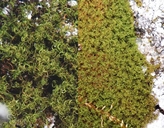- Map Distribution
- Description
- eFlora Distribution
- Illustrations
- Cal Photos images
- Elevation by latitude plot
MAP CONTROLS
1. You can change the display of the base map and layers by clicking on the layer control box in the upper right-hand corner.
2. California county polygons can be turned off and on in the layer control box.
3. Filling of Jepson subdivision polygons can be turned off and on in the layer control box.
Database links
UC Specimens in the University and Jepson Herbaria Public Portal
Specimens of Amphidium californicum in the Consortium of North American Bryophyte Herbaria portal (CNABH)
Amphidium californicum
Plants to 4 cm high in dense cushions, yellow-green to olive-green. Leaves crispate when dry, erect-spreading when moist, to 4 mm long, more than 10: 1, linear to linear-ligulate with a bluntly acute apex. Median cells quadrate to very short rectangular, rather thick walled, to 10 µm broad, 1–1.5: 1, with 4–6 rows of cuticular papillae over each row of cells. Marginal cells not at all differentiated. Basal cells to 14 µm broad, to 5: 1, rectangular with straight and thin lateral walls, arranged in regular rows, not pitted. Costa occupying about 1/6 of leaf base, little tapered above, ending a few cells before the apex. Costa cross-section. Margin recurved at least near base, remotely serrulate with the outline of the serrulations describing a 90 degree angle. Axillary hairs to 250 µm, 6-celled, with no basal brown cells. Stem without central strand, very thin walled throughout except for a one or two layers of thicker waller, much smaller outer cortical cells.
Dioicous with male and female plants similar. Perichaetial leaves somewhat erect and exceeding the capsule. Seta to 2 mm, yellow to yellow green, straight, smooth. Capsule pale brown. Urn nearly globose, erect and symmetrical, to 1.5 mm long, sulcate but not strumose. Annulus not differentiated. Operculum short rostrate, to 1/3 as long as urn. Peristome absent. Exothecial cells rectangular, in regular rows, to 25 µm wide, to 4: 1, rather thin-walled. Stomata present on short neck. Spores smooth, to 12 µm.
This plant is endemic to low to medium elevation sites in the more moist areas of west coastal North America. It is almost always found on rock faces and in rock crevices, often in rather deep shade. One should look for its tight cushions of olive green plants whose leaves are so crispate as to tangle with one another. Sometimes it is hard to find the marginal teeth which are the primary discriminant from the primarily eastern United States A. mougeotii. In such cases, the denser placement of the papillar streaks may allow identification.
Vouchers: Del Norte Co.: Smith River, Jedediah Smith Redwoods State Park, Norris 67327; Modoc Co.: near Mayfield Ice Caves (Siskiyou Co.), Norris & Hermann 22157; Siskiyou Co.: Upper Cliff Lakes, Klamath National Forest, Norris 53007; Sonoma Co.: The Cedars north of Cazadero, Ertter & Raiche 12859 (UC); Tulare Co.: Potwisha Campground, Marble Fork Kaweah River, Sequoia National Park, Shevock 12976.
Literature: Bourell 1981; Harpel 1980a; Harthill et al. 1979; Holmberg 1969; Koch 1950a, 1951e; Lawton 1971; Long 1978; Spjut 1971; Strid 1974; Toren 1977; Yurky 1995. As Anoectangium californicum Howe 1897. As Amphoridium californicum Lesquereux and James 1884; Moxley 1928. As Zygodon californicus Lesquereux 1868; Watson 1880.
Geographic subdivisions for Amphidium californicum: CaR, CW, MP, NW, SN. |
Illustration References: Malcolm et al. 2009 p. 96; Lawton 1971.






